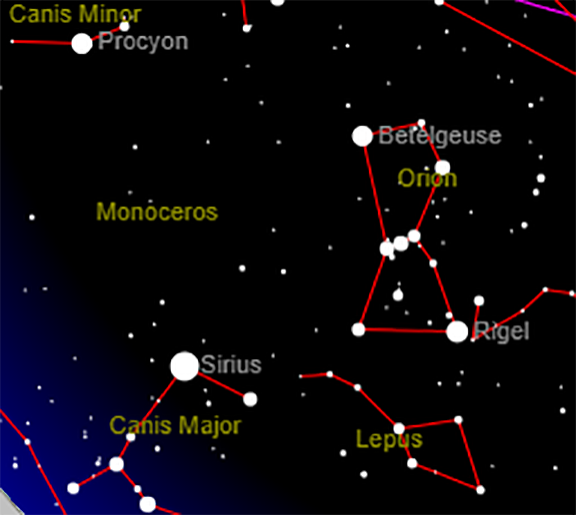
View to the south of southeast, early evening February. Courtesy Heavens-Above
The Dog Days of Winter
Last month, I wrote about Orion, the dominant constellation of the winter months. In February, it is perfectly natural to mention his hunting dogs. I will also quickly update some February sky events.
As mentioned last month, on clear nights, which can be scarce at this time of year, it is easy to find Orion in the southern part of the sky. Three stars from the belt, surrounded by a rectangular box of stars. If you draw a line through the belt stars to the lower left on February evenings, it points to the Dog Star, Sirius.
To me, Sirius appears white hot, tinged a little with blue, as seen to the eye or in binoculars. It is about twice as massive as our Sun and 25 times more luminous. Sirius is the closest star to the Sun visible to the naked eye from our latitude, at a distance of 8.6 light years. This combination of light output and relative closeness make it easily the brightest star seen in the night sky. Appropriately enough, translated from the Greek, Sirius’ name means “scorcher” or glowing.”
If you see a non-moving starlike object that is brighter than Sirius, it more than likely is a planet. Such is currently the case, as Sirius is vastly outshone by Venus, utterly dominating the western sky for over two hours after sunset. During the first half of February, Mercury, the innermost planet, joins Venus. Find a spot with an open view to the west to southwest horizon. Mercury will be the only fairly bright “star” below or somewhat to the lower right of Venus, about 45-60 minutes after sunset. Binoculars may help reveal Mercury a little earlier in brighter twilight, or to keep it in view for a few more days after Valentine’s Day, as it fades as it turns its lit side away from Earth.
Last month’s blog entry mentioned that Betelgeuse, the star at the northeast corner of Orion’s rectangle, had faded to less than half of its normal brightness. At this writing (January 30), it has dropped even a little more, equaling Bellatrix, the northwest corner star of the rectangle. As can be seen in the picture, taken from Heavens-Above, Betelgeuse, Sirius, and Procyon form the Winter Triangle. Procyon’s name means “before the Dog”, as it comes up a little before Sirius when both are rising in the east. Often overshadowed by Sirius, Procyon nonetheless shines as the eighth brightest star in the sky. It is also a nearby star at a distance of 11.5 light years, and is about 7 times more luminous as the Sun. To me, Procyon’s white color is tinged a bit with yellow, making it look decidedly different from Sirius. One thing that the two have in common is that both have tiny white dwarf companion stars that can be seen in good telescopes.
Sirius and Procyon are parts of the constellations Canis Major and Minor, respectively. Both served as Orion’s hunting dogs in mythology. Perhaps Orion is hunting Lepus, the Hare, whose dim stars appear below him in the sky. If you are close to the city lights, binoculars can help you trace out the pattern of Canis Major and Lepus, but you will look in vain to make a dog or even a puppy out of Canis Minor. It has just two stars easily visible to the naked eye. Next month, we will continue our exploration of Orion’s neighbors in the sky.
